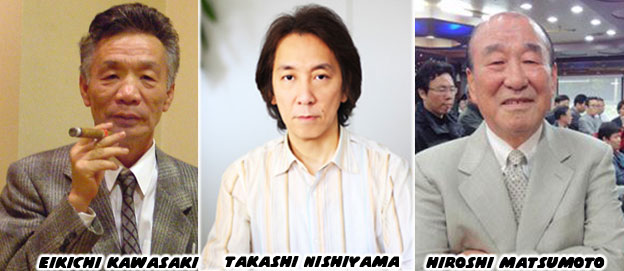
SNK founder and boss Eikichi Kawasaki had a keen insight to what gamers wanted. Unlike other company presidents who sat back and let his team develop hits he was actively involved producing many of their early titles. Mr. Nishiyama and Mr. Matsumoto had plans for a Street Fighter successor but the industry was evolving so rapidly that what it meant to have a fighting game was literally changing from month to month. Many arcade veterans would consider Technos’ game Karate Champ as the forefather of the modern fighting game. In 1984 it introduced audiences to the idea of traveling from place to place to fight other karate masters. There were even bonus stages in the game where players broke bricks and punched bulls. Some of these things found their way into the original Street Fighter. The colors for player 1 and player 2 could even be considered the inspiration for Ryu and Ken respectively.
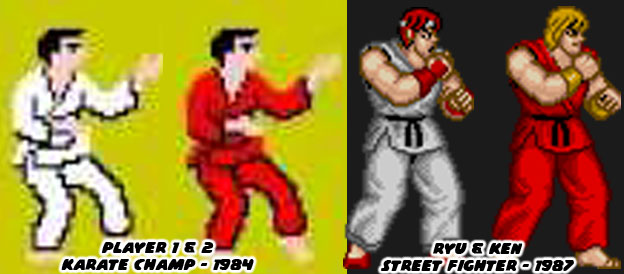
To say that Street Fighter was solely based on one game, or even one myth was wrong. There were a few other games that shaped the industry as well. In 1984 Irem released Kung-Fu Master, that Mr. Nishiyama had also developed when he was with Irem. This game had a hero fighting wave after wave of different types of opponents in a nonstop showdown. It was essentially the foundation of the brawler as well as a key piece in the development of the fighting game genre. 1984 was also important because of Punch-Out!! The Nintendo hit introduced stylized opponents from different countries and different weight classes as well. The first-person perspective in a fighter was rarely used but Nintendo demonstrated that it could be done. Then there was Yie-ar Kung Fu by Konami. In 1985 the company added the concept of life bars to the genre. Also it introduced different schools of martial arts, some with weapons, and it featured the first Chinese female martial arts opponent as well.
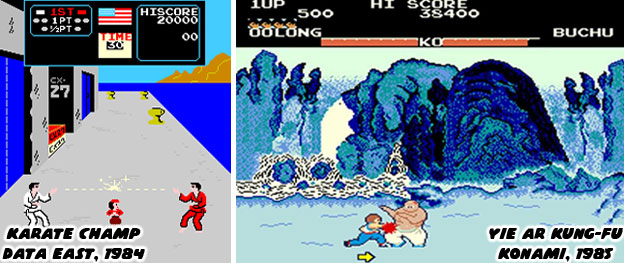
The action titles from ’84 and ’85 things colored the development of the fighting genre. When Street Fighter was released in 1987 Capcom made sure that it was bigger and better than anything that preceded it. Karate Champ may have been the roots but this game was so much more. The new stars, Ken and Ryu, would travel the globe and take on challengers of every background. Mr. Nishiyama and Mr. Matsumoto didn’t create a generic martial arts tournament, they instead pulled in influences from pop culture. The movies, the comics and cartoons they enjoyed inspired the setting and opponents of Street Fighter. More than that they helped inspire the development of special attacks like the hadouken or fireball. Street Fighter wasn’t the breakout hit that the company expected it to be. Instead there was a game by Technos that ruled arcades that year. Double Dragon was a new type of fighting game. Audiences all over the world were instantly hooked on this brawler. It was essentially a pseudo-3D version of the Kung-Fu Master story. An evil gang kidnaped a girl but instead of one person fighting to get her back it was two. These two could punch, kick, grab and throw opponents. No other game had that many attacks or “combination” moves. Billy and Jimmy Lee were stars for a new generation. There was nothing traditional about these heroes. They were tough guys from the street, vigilantes that took justice into their own hands. Audiences could identify with them easier than they could a martial artist in ancient China.
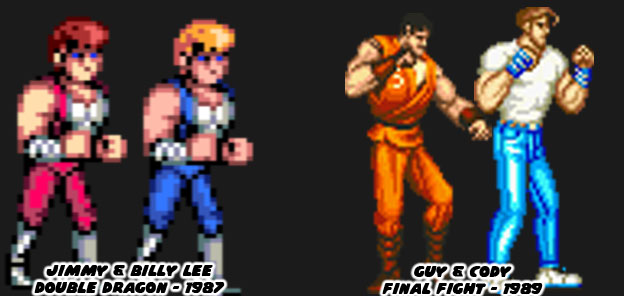
Double Dragon would have a profound influence on the industry. Studios were forced to change with the times or audiences might skip their next release. Any plans for a Street Fighter sequel were scrubbed as Mr. Nishiyama and Mr. Matsumoto left to join SNK. The designers taking over at Capcom, Yoshiki Okamoto, Akira Nishitani and Akira Yasuda wanted to make the next Street Fighter a superior version of Double Dragon. You know the story by now of how Final Fight was originally called Street Fighter ’89. It was no accident that the stars of this game were not Ken and Ryu but instead a more contemporary Cody and Guy. Their sprites were bigger and more detailed than Billy and Jimmy Lee. They fought through a bigger city and had more moves and more opponents to deal with as well. Final Fight was one of dozens of Double Dragon clones that came out over the next few years. Many for the arcade but some for the consoles as well. Of these developers Konami put out some of the best brawlers and I dare say that Vendetta (1991) might be peak Double Dragon clone.
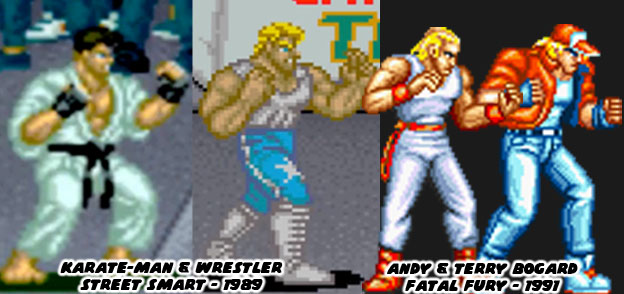
SNK had not yet released the Neo Geo console but the company saw where the arcade industry was headed. Specifically the President and Founder Eikichi Kawasaki saw that fighting games was the next big trend. He had his team begin working on new experiences. One of the most important and often overlooked titles that Mr. Kawasaki produced was called Street Smart. It was a sort of “missing link” between the brawler and the modern fighting game. It had a sense of depth like Double Dragon and even had a broad stage that allowed players to move far left and right. There were a number of different opponents each with techniques and abilities. It was the first fighting game to feature the Brazilian art of Capoeira, the Stage 2 boss “Slippery” Sam Santana could flip, tumble and strike. This game also featured an unlicensed version of I can’t turn you loose, an old Otis Redding tune made popular by the Blues Brothers. Poached music aside this game was important because it allowed for two players to team up against two opponents at the same time. It had a frenetic energy about it and being able to double-team an opponent felt very rewarding.
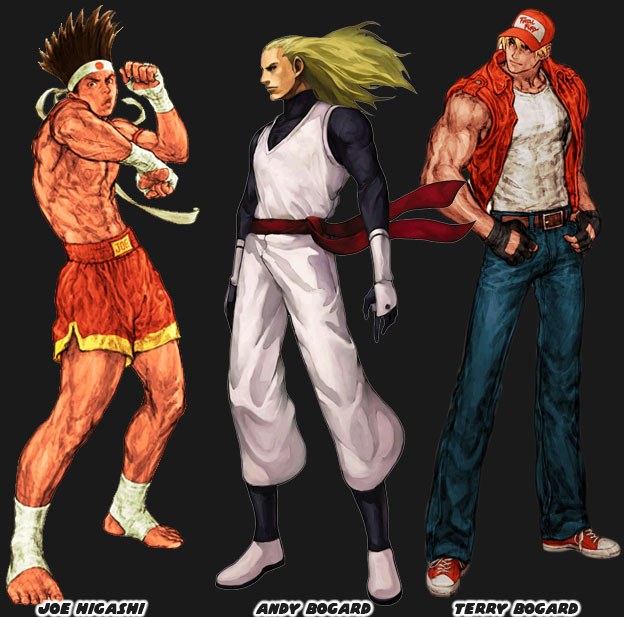
Mr. Kawasaki was a fan of the fighting arts and was even an amateur boxer in his youth. He knew a thing or two about real fighting. The idea of mixing up the forms intrigued him and he made sure that he had both a karate or wrestler be playable in Street Smart. It was SNK’s next game that helped put them on the map. Mr. Nishiyama and Mr. Matsumoto had their hands full trying to stay one step ahead of the competition. Street Fighter II exploded on the scene in February 1991. Somewhere in between Street Fighter and the original Fatal Fury the duo considered making a fighting game like Double Dragon with at least three playable characters. They had to act fast as Street Fighter II was gaining momentum. They narrowed their idea to a traditional fighting game but kept three main characters and even the ability to jump between the foreground and background. Fatal Fury was released at the end of 1991 and was an answer to both Final Fight and Street Fighter II. Audiences gravitated to the unique library of characters. Traditional fighting arts masters were balanced out by modern brawlers in street clothing. In fact you could see the spectrum in the main characters. Joe Higashi looked like a traditional May Thai specialist. His shorts, his taped hands and feet, dark tan and bold colors were classic. Andy Bogard was a sort of ninja-hybrid, his costume wasn’t quite classic nor was it quite modern, his design was literally a bridge between the old world and the new. If Joe was a nod to the past then Terry Bogard represented the future.
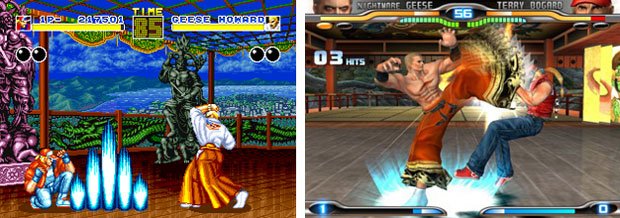
Terry Bogard was a new type of hero, the modern action film star. The days of Japanese karate masters being the heroes of the game were coming to an end. Some companies didn’t get the memo and kept rehashing old ideas, that’s why not many of those copycat fighting games were around today. Terry was a literal street fighter. He wore street clothing; a trucker cap, leather jacket, jeans and sneakers. He learned how to fight growing up on the rough streets of South Town. Of all the SNK heroes he was the one that went the furthest despite having a formal martial arts instructor. When SNK put him up against Geese Howard, the man who murdered his father, they created one of the great rivalries in fighting game history. Mr. Kawasaki and his star developers had a hit on their hands. It was the mix of traditional and modern character designs that helped put SNK on the map. When SNK’s next major fighting game was released it cemented their school of design. We will look at this in the next blog. As always if you enjoyed this blog and would like to sponsor me please visit my Patreon page and consider donating each month, even as little as $1 would help make better blogs and even podcasts!

cool
ReplyDelete